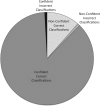PHACTS, a computational approach to classifying the lifestyle of phages
- PMID: 22238260
- PMCID: PMC3289917
- DOI: 10.1093/bioinformatics/bts014
PHACTS, a computational approach to classifying the lifestyle of phages
Abstract
Motivation: Bacteriophages have two distinct lifestyles: virulent and temperate. The virulent lifestyle has many implications for phage therapy, genomics and microbiology. Determining which lifestyle a newly sequenced phage falls into is currently determined using standard culturing techniques. Such laboratory work is not only costly and time consuming, but also cannot be used on phage genomes constructed from environmental sequencing. Therefore, a computational method that utilizes the sequence data of phage genomes is needed.
Results: Phage Classification Tool Set (PHACTS) utilizes a novel similarity algorithm and a supervised Random Forest classifier to make a prediction whether the lifestyle of a phage, described by its proteome, is virulent or temperate. The similarity algorithm creates a training set from phages with known lifestyles and along with the lifestyle annotation, trains a Random Forest to classify the lifestyle of a phage. PHACTS predictions are shown to have a 99% precision rate.
Availability and implementation: PHACTS was implemented in the PERL programming language and utilizes the FASTA program (Pearson and Lipman, 1988) and the R programming language library 'Random Forest' (Liaw and Weiner, 2010). The PHACTS software is open source and is available as downloadable stand-alone version or can be accessed online as a user-friendly web interface. The source code, help files and online version are available at http://www.phantome.org/PHACTS/.
Supplementary information: Supplementary data are available at Bioinformatics online.
Figures



References
-
- Clarke K.J. Virus particle production in lysogenic bacteria exposed to protozoan grazing. FEMS Microbiol. Lett. 1998;166:177–180.
-
- Clark D.W., et al. Effects of growth medium on phage production and induction in Escherichia coli K-12 lambda lysogens. J. Biotechnol. 1986;3:271–280.
-
- Gini C.W. Variability and Mutability, contribution to the study of statistical distributions and relations. Studi Economico-Giuricici della R. Universita de Cagliari; 1912.

